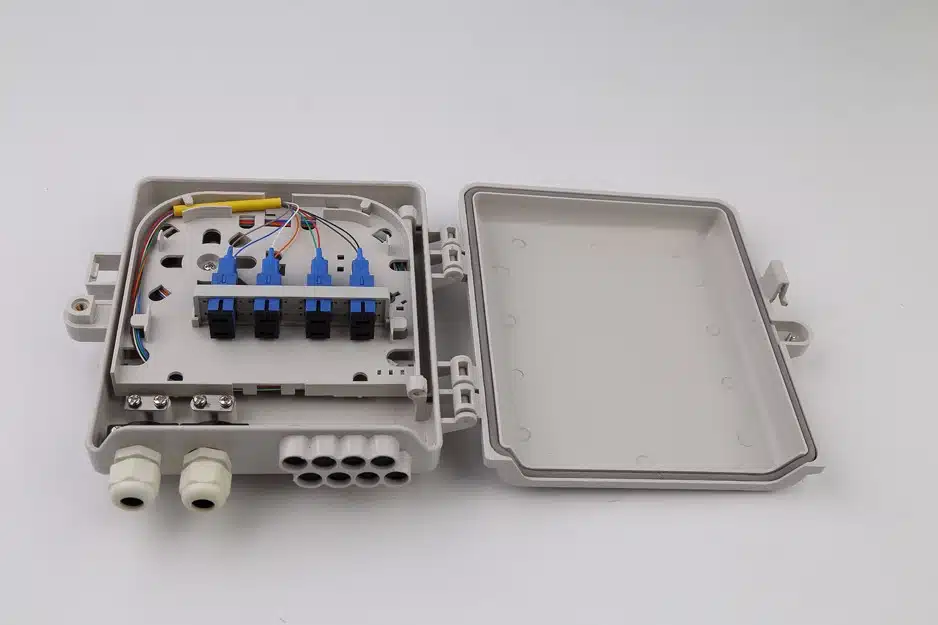
Glasfaser-Verteilerbox, auch als Glasfaserverteiler bekannt, ist eine wesentliche Komponente in Glasfaserkommunikationsnetzwerken. Es spielt eine wichtige Rolle bei der Organisation, Verwaltung und dem Schutz von Glasfaserkabeln und gewährleistet einen zuverlässigen und effizienten Netzwerkbetrieb.
Struktur und Funktion
Eine Glasfaserverteilerbox besteht typischerweise aus einem kastenförmigen Gehäuse, in dem sich eine Reihe von Glasfaserkabel und Komponenten. Die interne Struktur ist so konzipiert, dass die Kabel ordentlich und übersichtlich angeordnet sind, was eine einfache Identifizierung und Wartung ermöglicht.
Die Hauptfunktion einer Glasfaserverteilerbox besteht darin, einen zentralen Anschlusspunkt für Glasfaserkabel bereitzustellen. Sie ermöglicht die Terminierung und Verbindung von Glasfaserkabeln und sorgt so für eine effiziente Signalübertragung innerhalb eines Glasfasernetzes. Die Box enthält Glasfaseradapter, die den Anschluss von Glasfaserkabeln an andere optische Geräte oder Glasfaserkabel ermöglichen.
Glasfaserverteilerkästen spielen auch eine wichtige Rolle beim Schutz von Glasfaserkabeln vor Beschädigungen. Sie bieten den Kabeln mechanischen Schutz und schirmen sie vor äußeren Einflüssen und Umwelteinflüssen wie Staub und Feuchtigkeit ab. Die Kästen sind in der Regel aus robusten Materialien gefertigt und verfügen über versiegelte Türen und Dichtungen, um den Kabeln im Inneren maximalen Schutz zu bieten.
Darüber hinaus ist die Glasfaserverteilerbox auch ausgestattet mit Spleißkassetten oder Spleißhalter, die die Installation von Glasfaserspleißen ermöglichen. Diese Spleiße werden verwendet, um zwei Glasfaserkabellängen zu verbinden oder ein Glasfaserkabel mit einem anderen optischen Gerät zu verbinden. Die Schalen oder Halter sind normalerweise mit Rillen oder Führungen versehen, um die Spleiße sicher an ihrem Platz zu halten.
Anwendungsbereiche
Glasfaserverteilerkästen werden häufig in verschiedenen Glasfaser-Kommunikationsnetzen verwendet, unter anderem in den folgenden Bereichen:
- Rechenzentren: In Rechenzentren werden Glasfaserverteilerboxen verwendet, um Glasfaserkabel zu terminieren und zu verwalten, die Server, Switches und andere Netzwerkgeräte verbinden. Die Box bietet einen zentralen Punkt für die Kabelorganisation und einfache Wartung und gewährleistet eine zuverlässige Datenübertragung innerhalb des Rechenzentrums.
- Telekommunikationsnetze: In Telekommunikationsnetzen werden Glasfaserverteilerkästen zum Abschluss und Anschluss von Glasfaserkabeln verwendet, die Basisstationen, Mikrowellenverbindungen und andere Kommunikationsknoten verbinden. Sie ermöglichen eine flexible Kabelführung und eine effiziente Verwaltung der großen Anzahl beteiligter Kabel.
- Innennetzwerke: In Innennetzwerken, wie sie in Bürogebäuden oder Hotels zu finden sind, werden Glasfaserverteilerboxen zum Verbinden von Glasfaserkabeln zwischen verschiedenen Stockwerken oder Gebäuden verwendet. Sie bieten praktische Zugangspunkte zum Hinzufügen oder Warten von Glasfaserkabeln und gewährleisten eine zuverlässige Netzwerkkonnektivität im gesamten Gebäude.
- Außennetzwerke: In Außennetzwerken, wie sie beispielsweise für Straßenbeleuchtung oder Verkehrsleitsysteme verwendet werden, werden Glasfaserverteilerkästen verwendet, um Glasfaserkabel aufzunehmen und zu schützen, die im Freien oder unterirdisch verlegt werden. Sie schützen die Kabel vor Umwelteinflüssen und gewährleisten eine zuverlässige Signalübertragung über große Entfernungen.
Abschluss
Glasfaserverteilerkästen sind eine wichtige Komponente in Glasfaserkommunikationsnetzwerken und spielen eine zentrale Rolle bei der Organisation, Verwaltung und dem Schutz von Glasfaserkabeln. Ihre vielfältigen Anwendungsbereiche umfassen Rechenzentren, Telekommunikationsnetzwerke, Innennetzwerke und Außennetzwerke. Mit ihren erweiterten Funktionen wie Kabelmanagement, Spleißschutz und Umweltversiegelung sorgt sie für einen zuverlässigen und effizienten Netzwerkbetrieb. Das Verständnis der grundlegenden Struktur und Funktion von Glasfaserverteilern ist für jeden, der in der Glasfaserkommunikationsbranche arbeitet, unerlässlich.
